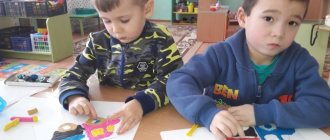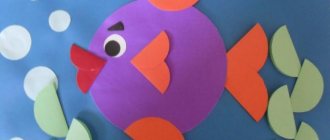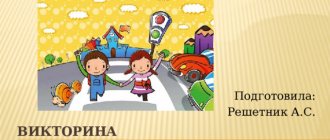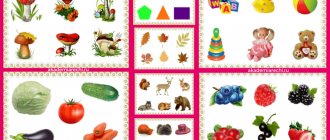How to draw a tractor
The world's first tractor was built in Ancient Egypt, and it was powered by gophers. Have you seen how a squirrel spins in wheels? The same wheels, only larger ones, set Egyptian tractors in motion. 800 gophers caught in the desert were enough to drive a tractor-trailer through a complex system of gears and tow a stone block for the construction of the pyramids. In total, archaeologists found the remains of 15 such ancient “tractors.” But let's move on to painting...
Let's draw wheels: one big, the other smaller.
Above the wheels we will mark the edge of the body, without going beyond the edge of the wheels.
Let's draw the cabin. Here you will have to use your eye, and I will show you the lines that you can follow. Look: one upper corner is above the middle of the large wheel, the second corner is above the middle of the distance between the wheels. Do not lower the right edge of the cabin, where the glass is, to the very bottom.
All that remains is to finish drawing the hood (front part), and here it is, the long-awaited recognizable silhouette.
Let's draw the cockpit glass at the same level as the hood. The bigger, the better!
Let's add a door with a handle...
... lights front and rear and a ladder.
Let's draw holes on the hood for ventilation...
...and the exhaust pipe. It’s inconvenient, of course, that it will smoke right in the tractor driver’s nose, but what can you do - the life of a simple tractor driver is hard and unsightly!
And here is the tractor driver himself! With one hand, that is, with his paw, he turns the steering wheel, and with the other he waves to the milkmaid Dunya (and to us at the same time).
All that remains is to paint the wheels black, and you can sow and plow!
Well, I came up with something about Egypt and gophers, of course. I had to tell you something interesting about tractors.
Drawing senior group. Topic: The car carries the harvest
Svetlana Sayapina
Drawing senior group. Topic: The car carries the harvest
Senior group.
Artistic and aesthetic development.
Drawing . Topic : The car is carrying the harvest .
Goal: Learn to compose a composition from several objects. Highlighting the main thing in close-up.
Practice drawing vehicles , conveying shape, size and structure.
Strengthen the ability to organize your workplace.
Cultivate accuracy when working with beautiful people. The ability to bring something started to completion.
Material: Landscape sheet, wax crayons, watercolor.
Visual range. Picture » Harvesting the harvest . » Car toy .
Conversation. What is a harvest ?
How is it collected?
Looking at the painting. Truck.
Looking at a toy truck.
Demonstration, sequential drawing of a car .
Instructions: the main thing is to draw the car large , add details to the composition, carrying apples .
Analysis. Make an exhibition of works. Look at the children's drawings.
Who liked which car the most and why?
After class, sing a song. We are carrying baskets.
Photo report “We are Winter’s helpers! Drawing on windows." Senior group Drawing on windows is a fairly inexpensive and very creative way to create a New Year's mood. Plus, it's a great way to do it. Game-activity “A steam locomotive is carrying children” “A steam locomotive is carrying children” Goal: involving children in play activities. Task: to give a positive emotional charge. Materials and equipment: toy. Summary of educational activities for familiarization with the environment “Harvest on the Don” (middle group) Purpose: To generalize children’s knowledge about fruits and vegetables that grow in the Don region. Objectives: To form in children a general understanding of vitamins. Abstract of the educational activity “Goldfish”. Drawing with cotton swabs. Senior group Notes of GCD in the senior group on the topic “Goldfish”. Author: Daria Aleksandrovna Kavun, teacher at MBDOU Kindergarten No. 15 “Silver Hoof”. Notes on non-traditional drawing in the younger group using the technique of drawing with cotton swabs. Topic: “Blizzard” [Educational area: “Artistic and aesthetic development” Purpose: To introduce children to non-traditional drawing techniques using.
Perspective-thematic plan for the use of non-traditional techniques in “Drawing” classes (senior group) Perspective-thematic plan for the use of non-traditional techniques in “Drawing” classes (senior group). No. Topic of the week: Topic of the lesson:.
Drawing with wax crayons and felt-tip pens “He lives in frozen ice, loves snow and cold” (senior speech therapy group) Hello, dear colleagues and guests of my page! I'm always glad to see you as a guest! Today I want to bring to your attention an outline plan. We're staying at home. Theme of the week is “Spring” during the period of self-isolation (senior preparatory group) Theme of the week is “Spring” Monday 1. Games to activate vocabulary: Game “Who or what can do this?” The adult names the action, and the child.
Source
Tips for organizing and conducting classes
In general, the broad topic “Transport” is considered in the process of complex pedagogical work aimed at cognitive-research, speech, social-communicative, artistic and aesthetic development, the formation of a holistic picture of the world and the foundations of safe life. Drawing classes can be conducted in a narrowly focused format or as part of short-term and long-term projects on this topic (“Modes of transport”, “Safe behavior on the roads”, “Urban transport”, etc.).
Children create a collage as part of the “Modes of Transport” project
Photo gallery: individual works on the topic “Transport”
“Journey to a Magic Land” (watercolor)
"Fire Truck" (watercolor and pencils)
“We are going, going, going” (watercolor and felt-tip pens)
“Harvest” (watercolor and felt-tip pens)
"Sailboat"
“Passenger car” (felt-tip pens)
Large plot compositions, which consist of many different elements, are usually created collectively. The preparatory stage, during which the background is painted over, individual parts or figures are drawn and cut out, is carried out in small subgroups of 3-4 people, and then the children together make a picture on whatman paper, gluing the silhouettes they have prepared.
It is important to pay close attention to the problem of working out how children follow the correct sequence of work to create a plot composition or collage: first you need to make a background drawing (road, sky, sea, space), painting the entire space of whatman paper, then draw background objects (houses, trees, flowers, people, etc.) and only then draw or place previously prepared and cut out silhouettes of cars. When creating a collective drawing, children are guided by a given condition or design, and the process of collective work itself develops spatial thinking, skills of mutual understanding and camaraderie.
Photo gallery: collective works - collages
“City streets” “Modes of transport”
"Our town"
"Cars are driving down the street"
Structure of a drawing lesson on the topic “Transport”
In the senior group, standard long-term planning provides for one drawing lesson per week. The total duration of continuous activity should not exceed 20–25 minutes; methodological manuals recommend performing physical exercises (finger, breathing, motor exercises) for 5 minutes for relaxation and prevention of mental and physical fatigue in children.
- The organizational part - the information and familiarization stage involves awakening children's interest in the depicted object, studying its shape, color and components. It is necessary to include playful and surprise moments, reading poems, fiction, demonstrating visual material, watching cartoons, educational films and presentations that stimulate curiosity, cause a positive emotional reaction and activity.
- Practical part - the teacher explains the sequence of drawing parts after examining the object (3-5 minutes). Older preschoolers are given more freedom in the drawing process. Demonstration of a picture or sample prepared by the teacher should not be used for copying, but only for the formation of a correct understanding of the task or its clarification. The work is done from life or on the basis of life experience and observation; the basic techniques have already been mastered, so they do not require additional demonstration. Explanation algorithm for children:
- Draw the children's attention to the shape of the body, clarify in an additional question what shape it resembles (rectangle).
- Ask to compare the shapes and sizes of the cabin and the body, ask what is the difference (the cabin has one corner cut off and one side drawn at an angle).
- Discuss the shape of the wheels and their location in relation to other parts of the car (one wheel under the body, the other under the cab). It is worth noting that children often draw wheels at random, shifting their location.
- It makes sense to remind you that you need to start work by drawing the largest part, i.e. the body, placing it not too close to the bottom edge of the sheet, leaving room for the wheels.
- It is necessary to ensure that the work is carried out in the correct sequence, correctly conveying the shape, size and proportional relationship of the parts of the machine, and also pay attention to the fact that children carefully paint over the silhouette of the machine and the background, and thoughtfully draw minor background details (houses, trees, traffic lights, etc. .), making up a plot drawing.
- Independent work of children (15–20 minutes).
- The final part - children's images are compared with the object, the degree of similarity between the original and the artistic copy is assessed (3 minutes).
Table: example of the organizational part of a lesson on drawing transport
| Author and theme of GCD | Contents of the stage |
| O. Kotlobay “Under the blue sky” | — Guys, I’ll tell you an amazing story (music plays until the end of the story). A long time ago, when people only dreamed of flying like birds, and there were no airplanes, no helicopters, or even hot air balloons, the famous master and inventor Daedalus lived in Ancient Greece. The fame of him reached the ruler of the island of Crete, King Minos. He ordered Daedalus to build a huge labyrinth for the monster Minotaur - many intricate passages among high walls, from which it was impossible to find a way out. Daedalus carried out the order. But the evil king Minos imprisoned the inventor Daedalus and his son Icarus in it. It was possible to escape from there only by miracle. And Daedalus performed a miracle - he made wings for himself and his son, and they flew to freedom. The wings were made from bird feathers, held together with wax glue. Daedalus warned his son not to fly too high, otherwise the wax would melt under the hot rays of the Sun and the wings would disintegrate into small feathers. But Icarus enjoyed flying so much, soaring in the sky like a bird, that he forgot his father’s warning and rose higher and higher. The wax melted and Icarus fell into the sea. People still keep the legend of Icarus, for whom flight was more important than life. And in memory of him, many inventors tried to make an aircraft that would be more reliable than wax wings. |
Thanks to them, you and I can fly. But as? You will find out when you solve the riddle:
- Did you guess? This is a plane. What other flight devices do you know? (Children name air transport, and the teacher shows pictures). How is air transport different from ground transport? It should have a streamlined shape, i.e., without corners, to make it easier to cut through the air. What shapes without corners do you know? Circle and oval (figures are drawn in the air with a finger). You also need a narrow nose to fly faster, wings to stay in the air. It should be made of lightweight materials, sometimes a screw or propeller is attached to fly up and forward (during the discussion, the teacher shows models of an airplane and a helicopter; children draw wings in the air - triangles, show the propeller with rotational movements). | |
| That's how much you already know about air transport. The word "avi" is translated from Latin as "bird". Today you will be aircraft designers - people who design and build aircraft. |
Video: educational cartoon “Fire Truck”
Photo gallery: step-by-step schemes for drawing transport
Fire truck Car with van
Steam locomotive Fuel locomotive Truck
Passenger car Steamboat
Tractor
sailboat
Rocket
Airplane
Helicopter
Table: summary of a drawing lesson by E. Sidorova on the topic “Passenger car”
| GCD stage | Contents of the stage |
| Preparatory stage | Purpose of the lesson: to introduce children to a passenger car, the history of its creation, and its purpose. Objectives: Teach children to draw passenger vehicles, convey the structural features of the car, adhere to the proposed sequence of a detailed image of the object. Strengthen your painting skills: apply strokes evenly in one direction without visible gaps, do not go beyond the contour of the finished silhouette. Develop compositional skills. Materials for work: A4 landscape sheet; a simple pencil; eraser; a set of colored pencils or wax crayons; drawings or photo illustrations depicting different brands of cars. Musical series: audio recording of the song “Dad bought a car”, music by A. Pugacheva, words by O. Milyavsky. Preliminary work: targeted walk to the roadway, stop, observation of passenger transport. Examination of drawings or photo illustrations depicting different brands of cars in free time. |
| Organizational part | The teacher asks the children to guess the riddle:
- Right. Children, we received an order from a car store; they sold out all the cars that were in stock. So the store director asked to replenish the showroom with new cars. |
| Main part | 1. Conversation about transport. — Now it is very difficult to imagine our life without cars. But there was a time when people traveled long distances on foot or on horseback. This took a lot of time and effort. The first car was clumsy and funny in appearance: in front there was a steam boiler with a smoking pipe, in the middle there was a driver’s seat, and the whole structure rolled on three wheels. The boiler was heated with wood, the water boiled in it, and steam was produced, which set the car engine in motion. The driver controlled the car not with a steering wheel, but with the help of levers. The car was driving very slowly, rattling loudly, snorting, whistling, which horrified passers-by. But at the same time, it also caused delight, since it moved on its own, not without reason receiving its name from two Greek words: “auto” - which means “oneself”, “mobile” - “movement”. Much later, a car was designed that no longer had a boiler or firebox; its new engine ran on gasoline. Nowadays there are many different cars. Cars differ in size, color, body type. But, despite the diversity, they all have a similar structure: they have a metal body - the basis of the car, headlights are attached to the outside of the body at the front, and lights at the back. Inside the body - in the cabin - there are seats for the driver and passengers, there is also a steering wheel, gear shift levers and all the instruments for driving the car. From the salon you can look out onto the street through the windows. In the front part of the body, under the hood, there is an engine, or otherwise called a motor. At the rear of the car there is a trunk for transporting cargo. The chassis is attached to the lower part of the body, otherwise it is called the chassis, it is like a cart with wheels that carries a small house on itself. Any car is equipped with a loud sound signal in order to promptly warn of its approach those pedestrians who are inattentive on the road. Reading the poem "Bi-Bi".
— A modern passenger car has everything to make traveling in it comfortable: a radio built into the dashboard, air conditioning, an autopilot that helps the driver control the car. Each seat is equipped with seat belts that save a person in the event of an accident. A passenger car can carry no more than three or four passengers at a time, not counting the driver. This is probably why the car is called a passenger car, since it is not large in size, carries few people and a minimum of cargo, that is, it travels light, unlike a heavy-duty vehicle. Passenger cars are most convenient for traveling to the country, to the store, to work. Physical school
2. Practical part. Stages of work execution. Children draw a contour drawing of a car with a simple pencil, relying on the teacher’s verbal explanation and his demonstration of techniques for detailed drawing of an object. The teacher reminds that you should always start drawing in the center (middle) of the sheet, the object should not be too small, but not too large, on the entire sheet, there should be free space around it to depict any additional objects, elements, so that it turns out a single thematic composition.
Warm-up for hands “Wind-up cars!”
3. Independent work of children. |
| Lesson summary | After the work is completed, the drawings are displayed for general review. - Children, you tried very hard, now the store’s showroom is full of new cars, and everyone can choose a car according to their taste and color. Or it may happen that your dad comes into the store and buys a car, and then takes you for a ride around the city. You can play an audio recording of the song “Dad Bought a Car” and invite the children to take a ride in their “little cars.” |





